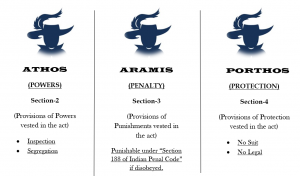This article is written by Adarsh Vasudeva, pursuing Certificate Course in Advanced Civil Litigation: Practice, Procedure and Drafting from LawSikho, and Ayesha Khan.
Table of Contents
Introduction
The Epidemic Diseases Act, 1897, has been enforced across the country several times, to deal with the outbreaks of diseases like swine flu, dengue, cholera, etc. Special provisions to implement containment measures that are required to control the spread of a disease are provided in the Act. It aims to prevent dangerous epidemic diseases from spreading in the country.
The Epidemic Diseases Act was first used to restrain the spread of the bubonic plague in Mumbai, then known as Bombay Presidency of the British India. Governor-General Victor Bruce granted the local authorities special powers enabling them to implement necessary measures to control the epidemic.
The law was thoroughly enforced to limit and control the plague epidemic at the time of its enactment, it conferred powers to search suspected plague cases in houses and among travellers. Affected people were segregated forcibly, infected areas were evacuated, disinfected and demolished.
Crowds, public meetings, assemblies were banned along with gatherings at festivals and pilgrimages were also suspended. There were allegations during this time, of violence, humiliation and misbehaviour against women because of the law which eventually led to out breaking of riots. To implement the law, the military was also used in several places by the government. Now, Covid-19 has left the country in desolation, as it has limited lifestyles and not just only transactions
This law is still relevant even after independence, since 1947 it has been used several times successfully for tackling epidemics by the Indian Government, restraining the outbreak of diseases.
Main provisions of the Act
Let’s take a turn into the fictional world and try to understand the provisions of this act through the characteristics of 3 musketeers.
- As Athos was the main among the three musketeers, provision of power is the most important clause of this act. It empowers the state to inspect any person traveling by railways or any other mode of transportation and it also allows the state to segregate persons who are suspected of being infected by any such disease.
Section 2 of this act allows states to take steps to discourage the transmission of any infectious illness that is outside the control of ordinary law by providing official notifications outlining interim laws that must be followed by the public. It specifies that if the State Government believes that such Acts are inadequate for the stated intent, it can issue a public notice prescribing temporary legislation for the public/class of persons to follow.
- By the power of Section 2A, the central government can take adequate steps to conduct an inspection of any ship arriving or departing India, and if the Central government is satisfied that any region of India is under danger related to any dangerous epidemic scenario, and that the ordinary statutes will not be able to handle the situation.
- In the same way, Aramis signifies Section 3 (punishment provisions) of this act. Any person who willfully goes against the provisions contained by this act will have to face the punishable provisions under section 188 of the Indian Penal Code. Section 188 of IPC deals with It’s also worth noting that, under Section 188 of the IPC, an attempt to injure isn’t required so plain knowledge of the order is enough to make you liable for the crime.
Disobedience to a public servant’s order is punishable by easy incarceration for up to a month and/or a fine of up to Rs. 200 if it “causes or threatens to cause interference, annoyance, or injury, or the possibility of obstruction, annoyance, or injury.” If the disobedience “causes or threatens to cause danger to human life, health, or safety, or causes or tends to cause a riot or affray,” it is punishable by up to six months in jail and/or a fine of up to Rs. 1,000. Violation of the Act’s provisions enacted in response to the Covid-19 epidemic, for example, would result in the latter penalty because it would endanger human life, fitness, and welfare.
- Porthos covers the officers who act under this act (section 4) and therefore no suit or other civil action can be brought against them. Section 4 of the act protects civil servants from legal prosecution when they are behaving in good conscience in accordance with the act’s rules.
Limitations of the Act
-
- The act was passed by the British Parliament more than 120 years ago to address a crisis that existed only in one region of undivided India, the Bombay Presidency. The true motivation of the British Parliament behind the act can be questioned for the specific explanation that British officers have used it to arrest and confine mass demonstrations led by freedom fighters.
- The aim of the Epidemic Act, 1897 is to deter the transmission of disease rather than to control or suppress a disease that has already begun to spread. The word “epidemic” or “disease” is not specified in the act.
- The act would not give the government clear guidelines or directives to obey in the event of an outbreak. If it believes that the outbreak cannot be contained by current legislation, the act simply empowers it to issue general interim notifications/regulations.
- The Epidemic Act, 1897 has no instructions for forming a special committee or crisis response panel that can respond to an emergency in a designated and preventative way without having to wait for the state government to act after taking into account other conditions in the state.
- The act makes no provision for the isolation of suspicious patients or the establishment of isolation centers. State governments should be directed to build isolation centers in all hospitals and housing communities to be used as isolation centers in the event of an outbreak.
- The act remains vague on the issue of how the government should administer vaccines and medications. Since the act is silent on any of these points, there is no basis for the general public to find the government liable in a court of law for any sort of wrongdoing on its part, since there is no legal mechanism by which the government may act.
More power to this warrior through the Epidemic Diseases (Amendment) Bill, 2020
On 14 September 2020, the Epidemic Diseases (Amendment) Project for 2020 was introduced in Rajya Sabha. It amends the 1897 law on epidemic diseases. The law ensures that deadly epidemic illnesses are prevented. The act amends the act to cover healthcare workers protected from infectious diseases and extends the authority to deter the transmission of these diseases through the central government. The bill abrogates the ordinance (amendment) issued on 22 April 2020 for epidemic diseases. The main purpose of this act is to shield health care workers, their residential premises, and workplaces from abuse during a pandemic.
Main features of the bill
- The act specifies that no person can commit, encourage or cause harm or destruction to any property during an epidemic by committing an act of violence against healthcare staff.
- The bill aims to ensure that any level of violence against healthcare workers and property destruction is not tolerated in any circumstances similar to the current pandemic.
- It makes incidents of violence on health workers treating COVID-19 patients a cognizable and non-bailable offence, with provisions of a penalty and a jail term of up to seven years.
- This act imposes a sentence of imprisonment of three months or five years and of a fine of 50,000 Rs to 2,00,000 Rs. on any commission or abetment of such abuse. The jail sentence shall be six months or seven years and the penalty shall be Rs 1-5 lakh if seriously injured is involved.
- Under the provisions of the bill, the offender would be presumed to be guilty of the offence unless proved otherwise by the accused defender.
- Persons accused of offenses according to the bill are also liable to compensate the health support staff they have injured. The fee owed by the claimant shall in case of injury or loss of property be double the fair market value of the destroyed or stolen property decided by the Court. The amount is collected as an arrear of land income in accordance with the Tax Recovery Act of 1890 when the accused man fails to pay the compensation.
- A police officer, not below inspector level, can prosecute cases reported under the bill. The inquiry must be concluded within 30 days of the first report being recorded.
- Within a year, the investigation or conviction should be completed. If the time limit is not concluded, the judge must report and prolong the time frame the reasons for the extension. The term shall not, however, be prolonged at a time for more than six months. The court will conclude that the defendant is guilty of the offence as he or she is prosecuted whether he or she does serious injury to a healthcare staff unless otherwise shown.
Significant case laws
-
Raj Mangal Ram v. State of Bihar
The case concerned some directives given by the Muzaffarpur District Magistrate for the enforcement of the “anti-Kalazar” system. It’s also worth remembering that, under Section 188 of the IPC, there’s no need for an intention to kill, because not knowing the warrant is enough to make you responsible for the offence. Courts will not take cognizance of an offence under Section 188 of the IPC merely because an FIR has been lodged. Section 195 of the Code of Criminal Procedure, 1973 (“CrPC”) demands that the related police in charge shall file a case. The prosecutions may be quashed if the terms of Section 195 of the CrPC are not followed.
-
J. Choudhary v. The State
In this case, a significant question came in front of the judiciary body of Orissa High Court, the query was that if a doctor fails to have himself vaccinated against cholera as demanded by the State Government’s regulations, then he would be liable under Section 3 of the act or not. The court came to the conclusion that as the intention of the doctor was irrelevant to the case, he would be liable under the section of the said act.
-
Ram Lall Mistry v. R.T. Greer
In Ram Lall Mistry v. R. T. Greer, during the discussion on the scope of Section 4 of this act, the Calcutta High Court in 1904, came to the conclusion that an omission to pay compensation as required by the act’s regulations would not be covered under Section 4.
Conclusion
COVID-19 elicited a mixed response from India. The solution includes a variety of statutes, regulations, programs, governing agencies, and national and state-level advisories. As demands for government intervention rise, the Epidemic Diseases Act has become a point of contention. The Infectious Diseases Act’s limited intent is for states to take special precautions for serious epidemic diseases, rather than creating a public policy framework. The statute grants the government broad powers to take coercive measures against citizens under this narrow context.
To win the war against coronavirus, we as citizens should serve this warrior (follow the provisions) and not disobey him, as we cannot afford to face the wrath of this disease.
References
Students of Lawsikho courses regularly produce writing assignments and work on practical exercises as a part of their coursework and develop themselves in real-life practical skills.
LawSikho has created a telegram group for exchanging legal knowledge, referrals, and various opportunities. You can click on this link and join:













